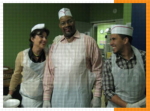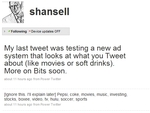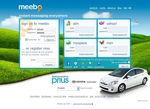Sharpie Confessions: A Life-Long Obsession
Posted in: Uncategorized Ok, ok. The world now knows about my secret Sharpie obsession, or at least all the customers and employees at my local Staples. There it was, a behemoth of Sharpie infatuation, a display with every color you could imagine – teal, sky blue, navy AND in various tips of fine, medium, broad. Could it be? Or was just a mirage?
Ok, ok. The world now knows about my secret Sharpie obsession, or at least all the customers and employees at my local Staples. There it was, a behemoth of Sharpie infatuation, a display with every color you could imagine – teal, sky blue, navy AND in various tips of fine, medium, broad. Could it be? Or was just a mirage?
Ever since my first days of creating art, the Sharpie has been my best friend and we have created some good times and great ideas together. Now my wildest dreams have come true with all the colors of the rainbow to choose from. Sharpie’s new product line and communications tell me one thing: it must be listening to its audience. With a website full of ideas, tutorials, contests, and opportunities for the fellow Sharpie-obsessed, it is deepening loyalty within consumers.
What can we learn from this? Taking our brands and tapping into the true connection they have with their target is key to communication and innovation. Sharpie could have pushed the brand’s connection with meetings, boardrooms, and diagrams, but instead chose to tap into the root emotion – the love to create. Bravo Sharpie!
Jinean Robinson is a CCIO (Chief Creative Infections Officer) who has been in the communications industry for over 8 years, specializing in creative strategy and implementation, 360 branding communications, and brand development. Join her at http://twitter.com/germllc or her firm’s website at http://germonline.com.
You’re Not on Twitter Yet?
Posted in: Uncategorized It’s out there and everyone’s talking about it. It’s been proven to give companies an edge on competition and the ability to form a bond with customers. So why aren’t you involved in social media yet?
It’s out there and everyone’s talking about it. It’s been proven to give companies an edge on competition and the ability to form a bond with customers. So why aren’t you involved in social media yet?
As a freelancer in social media, I’ve noticed that there are numerous corporations that are still not involved with Twitter, Facebook, or anything on the Internet beyond a website and an email. This is, in essence, what it would be like when everyone started to advertise on the television when it was first invented and a company simply ignored it and kept to the “old school” ways of handing out fliers to people. Although it is important to respect the more traditional ways of advertising, you must also incorporate the new to properly promote and advertise your company and brand (my fellow Beneath the Brand blogger Jon Leung agrees – check out his post Marketers’ Dilemma: Facebook or Twitter).
The best thing about social media – it’s easy and free. At the moment, I recommend starting with Twitter because, as I’m sure you’ve heard, it’s becoming more and more similar to the dot com boom (i.e. don’t be the last one to figure it out).
Look at Twitter this way: imagine all your customers coming together on a daily basis and talking about topics that pertain to you and your company, thereby spreading even more information about your company and gaining more recognition and consumers.
Let me use a company as an example that I am currently involved with: Dolphin Blue, Inc. Dolphin Blue helps businesses go green through its office supplies. If you thinking of promotion from a networking standpoint, the first thing you would do is to find a group that matches your interests, in this case, any green groups that deals with the ecosystem or world health. You would then attend the group sessions, meet people who have those same interests, and start conversations with them about your company. Twitter is exactly like this, only on a much larger scale.
After creating a Twitter account, log on to www.search.twitter.com and search (#green) for people talking about green issues. “Follow” them, re-tweet things they’ve tweeted that you agree with and *poof,* people will start following you, re-tweeting things you’ve posted, and, most importantly, become aware of your services. And thus, networking and building your business starts on a national level. The more people you meet, the more people who talk about you and your company.
Within four hours of Dolphin Blue publishing its Twitter account, it had six mentions and 26 followers! On day two, those numbers grew to 14 mentions and 93 followers. Imagine how many more people it’ll reach within the next week, month or year.
I think Griffin Farley of 22squared said it best. “Don’t plan for the ones you reach, plan for the ones they reach.” It’s all about who you know, right?
Megan Green is a freelance propagation planner who has had her work published on PR News Wire, as well as many other outlets. Contact her on LinkedIn, Facebook, Twitter, or at megankategreen@gmail.com.
Media Consumption Patterns: Reaching Teens
Posted in: Uncategorized Did you hear the one about the 15-year-old who decided to run his own study on the media consumption patterns of teenagers? It’s quite the research… er… story… lesson.
Did you hear the one about the 15-year-old who decided to run his own study on the media consumption patterns of teenagers? It’s quite the research… er… story… lesson.
Ben Kellogg of Group SJR forwarded me the article after we had spoken about an entirely unrelated subject. To be quite honest, I didn’t jump right on it… my laptop had died, losing files, email contacts, and programs. I just kept resetting the email reminder. Until today.
 Matthew Robson, a 15-year-old intern working for Morgan Stanley, conducted a media study called “How Teenagers Consume Media.” The conclusions caused a bit of an uproar, mainly because one teen does not represent all teens. Yet, it could also be said that the overall observations coincide with many teen media habits. The teens I know, for instance, would rather be online than in front of a television. Either that or doing both… watching TV and surfing the Web, interspersed with texting. Although there is absolutely no statistical backing for a survey of one, we can draw some general inferences from Robson’s writing.
Matthew Robson, a 15-year-old intern working for Morgan Stanley, conducted a media study called “How Teenagers Consume Media.” The conclusions caused a bit of an uproar, mainly because one teen does not represent all teens. Yet, it could also be said that the overall observations coincide with many teen media habits. The teens I know, for instance, would rather be online than in front of a television. Either that or doing both… watching TV and surfing the Web, interspersed with texting. Although there is absolutely no statistical backing for a survey of one, we can draw some general inferences from Robson’s writing.
General conclusions for the study include:
- Most teenagers are not regular listeners to radio, instead opting for online streaming services
- Most teens watch television, but frequency varies by season. Additionally, now that TV shows are webcasted as well, there’s less worry about missing an episode
- Teens do not read traditional papers because “they don’t have the time” (I am sure they have the time… it’s just that papers don’t rank highly on the priority list)
- Console gaming, interestingly, is not of interest to teenagers… and the main factor is cost. Costs for consoles and games are beyond most budgets; however, multi-player, interactive online games are popular
- The Internet is where teens interact socially, conduct research for school, create videos, IM, and otherwise connect to others… except for Twitter. Matthew states that teens do not use Twitter*
- Teens love music, but are not paying for it
- Viral marketing is enjoyed and supported by teens
- They do not use directories unless it’s online, etc.
*According to the graph below from Sysomos, teens comprise 30% of Twitter users:

This is directly in contrast with Robson’s assessment.
But hey, he is 15 years-old, and while he may be intelligent, his judgment is missing the crucial benefit of time. However, Morgan Stanley should not be lacking in the judgment column… or, in retrospect, maybe that’s exactly what they are missing…
Jeff Louis: Strategic Media Planner, Brand Project Manager, Writer & Blogger. Unlike the all the other blog writers for Talent Zoo, Jeff is cute and nice. Tweet him @jlo0312. Just kidding about the nice part.
Twitter Testing Contextual Advertising System
Posted in: UncategorizedDon’t Sell Just Sell It, Noit It!
Posted in: Uncategorized Can you feel it? Probably not…it’s much like the spin of the Earth. E-v-e-r s-o s-l-o-w-l-y, we’re being herded by unseen forces swirling about; price, comfort, security, and laziness. Why fight the crowds or the traffic when it can be done from home? If you don’t have to leave the house, then don’t.
Can you feel it? Probably not…it’s much like the spin of the Earth. E-v-e-r s-o s-l-o-w-l-y, we’re being herded by unseen forces swirling about; price, comfort, security, and laziness. Why fight the crowds or the traffic when it can be done from home? If you don’t have to leave the house, then don’t.
Massive online sites such as Ebay and Amazon make shopping online simple. Well, prepare to add another couch magnet to your arsenal: NoitWorld.com.
Before you ask:
In the US Military, the term “NOIT” is used to describe something as “cool” or “hip.” This Military slang term served as the impetus for the creation of this website, which combines the variety and diversity of a true online marketplace with the cool, hip world of social media.
NoitWorld, launched on June 1, 2009, heralds itself as the ”newest, coolest, and most consumer friendly online marketplace for buying and selling new and used merchandise. Although I have never used the site I did peruse it extensively. Very simple to navigate, users have the ability place products in more than 100 categories, such as Anything Goes, Motorcycles, Cars, real estate, etc. Depending upon the item being sold, ads are posted for 30 days and are either free, $20, or $25 per ad. The site is actually global in scope although most items listed currently are from the US or Mexico.
Noitworld.com, however, is not “just another sales site.” It is the first site of it’s type that allows users to re-post listings on social media sites like Facebook, Twitter, MySpace, LinkedIn, and more. Todd Foret and Sean Legros, both of Yuma, AZ, developed the sites unique strategy:
“With so many internet users spending a majority of their time on their social media sites, it only makes sense to provide a buyers and sellers market that can interact with these sites,” said Foret.
Although “in business” for just over a month, there are plenty of items available, from a classic Styx CD to a beach home in San Felipe, Mexico. As the economy doesn’t seem to be immediately bouncing back, maybe it’s time to start “Noiting” all stuff.
Jeff Louis: Strategic Media Planner & Brand Project Manager for B2B and B2C clients, he is fascinated by innovation in the face of adversity, branded creative that is on-strategy, and past participles. He can be contacted via Twtter or LinkedIn.
Advertising is Irrelevant?
Posted in: Uncategorized AdWeek and Harris recently released a poll asking those not involved in the advertising trade what they thought of advertising’s “relevancy.”
AdWeek and Harris recently released a poll asking those not involved in the advertising trade what they thought of advertising’s “relevancy.”
The results show that most find that our jobs, as a whole, are rather irrelevant.
Advertising’s down, no doubt, and now Adweek’s heaping salt on the wound!
Well, Mr. and Mrs. America, let’s look at a life without advertising. A life of relevance.
 First of all, without advertising, we would not have free access to television. Advertisers in essence pay for the shows we watch by running commercials. By the same logic, the web in that state would not be as comprehensive as the one we experience now. Radio would be a paid service with subscribers. Programs and shows with relatively lower ratings would be immediately slashed since they would no longer be able to support themselves.
First of all, without advertising, we would not have free access to television. Advertisers in essence pay for the shows we watch by running commercials. By the same logic, the web in that state would not be as comprehensive as the one we experience now. Radio would be a paid service with subscribers. Programs and shows with relatively lower ratings would be immediately slashed since they would no longer be able to support themselves.
The cultural art form of advertising would be lost. The circle of life would be disrupted. Just as life influences advertising, ads influence culture.
Without advertising, creatives would be cubicle-bound and non-imaginative. Serious. Boring. Sex would not sell, and neither would honesty. No one would fight for the cause. PETA would consist of two guys fighting for animal rights, and no one would care. Animals wouldn’t be cool to wear. Or not wear. Or own. Times Square would be dimly lit. Your favorite beer would be just “BEER,” as the term ‘generic’ would dominate store shelves. Color would be sparse. Trendsetters would be trend-less. No brands, no logos, no icons or spokespeople. No sexy models, sexy shows, or suggestive commercials. We wouldn’t know who to vote for, or why. Four hour erections? Who’d need the pills, let alone use them? No body-image, no silicone implants, no tummy-tucks. No Jon & Kate. Michael Jackson would just be another singer. No Hollywood trailers, stars, starlets, tramps, red carpets, or blockbuster openings. No E! TV, no TMZ. No Paris, Lindsay, Nicole, or reality TV. No Tila Tequila.
No PSA’s warning that your brain on drugs was scrambled. Or that kids shouldn’t smoke crack and that crack kills. Rather than axing the marketing budget first, corporations would axe employees. And that would be just fine, because there would be no PR effort, no big news story, therefore no downside.
Life would go on, but it would be bland and tasteless. Twitter, Facebook, YouTube and MySpace: no need for them.
Take a picture of the Cold War-era Russia and apply it to a life without advertising. Cold. Drizzling. Muddled.
The link to this study is now unavailable. Was the issue so unimportant that Adweek pulled the article? Or was the study published on the wrong day?
Luckily, I printed it:
In an AdweekMedia/Harris Poll last month, respondents were given a chance to say they don’t feel strongly about the industry one way or another, and nearly half of them took it. Asked to characterize their overall impression of “the advertising industry in general,” 47 percent said it’s “neither negative nor positive.” Predictably, those with a negative view of the business (9 percent “very,” 28 percent “somewhat”) outnumbered those with a positive view (2 percent “very,” 15 percent “somewhat”). (The total exceeds 100 percent due to rounding.)
If such numbers count as not-so-bad news for the ad business, responses were less positive on the question of whether consumers find advertising relevant to their lives (”By relevant,” Harris told respondents, “we mean how it connects to things that are ongoing in your daily life”). Given the effort put into aiming the right ad at the right target, the numbers here were pretty lackluster. Eight percent of respondents said advertising is “very relevant” to their lives, and 42 percent said it’s “somewhat relevant.” Thirty-two percent termed it “not that relevant” and 14 percent “not at all relevant,” with the rest unsure.
Can you say “OUCH!”?
Jeff Louis: Strategic Media Planner, Project Manager, and New Business Account Coordinator. His passion is writing. Reach out and touch him: www.linkedin.com or www.twitter.com.
Diddy Lied to Us. Taco Bell Sets Record Straight.
Posted in: UncategorizedToyota’s Prius Drives Over to Meebo
Posted in: UncategorizedSeed Bombs, Tweetolution, Spike Lee Spake
Posted in: Uncategorized– Houses come a-hunting on Twitter. (More proof that in this market, it’s do-or-die time.)
The Friendship Model: Brandon Murphy at 22squared Gives the Down and Dirty
Posted in: Uncategorized Advertising and marketing have taken new directions with the recent integration of social media and consumer advocacy. Agencies have been forced to rethink their ideas and strategies to reach their consumers. One such agency, 22squared, has done just that with the help of its SVP Director of Brand Marketing, Brandon Murphy.
Advertising and marketing have taken new directions with the recent integration of social media and consumer advocacy. Agencies have been forced to rethink their ideas and strategies to reach their consumers. One such agency, 22squared, has done just that with the help of its SVP Director of Brand Marketing, Brandon Murphy.
I had the opportunity to catch Mr. Murphy on the phone this past Friday and ask him about the company’s model, The Friendship Model: How to Build Brand Advocacy in a Consumer-Driven World.
“I think that basically it’s an approach for brands to build advocacy. When we first introduced this thing, it was mostly an internal thing, and actually still is. In essence it was an internal way to focus the agency on what marketing was about today, what a person does to make and maintain a friendship, earn enough respect, and I guess enough attractiveness for a consumer to advocate for them like a friend would advocate for a friend,” Murphy said.
Murphy says one of the hardest questions companies face when creating campaigns is the question, “How do we build advocacy?”
“A lot of times it comes down to not what you say but what you do,” he said. “How can we get the customer to interact with us. Your next customer could turn into your next 10 customers. It’s a pretty simple idea.”
Griffin Farley, senior brand planner from 22squared, has a great saying for this: “Don’t plan for the ones you reach, plan for the ones they reach.”
How can this model help an entire agency? I listed those questions and responses below:
Megan Green: For people now looking for work in progressive ad agencies, why is it important for them to know about advocacy, social media and word of mouth?
Brandon Murphy: The simple reason is because that is how brands are growing now. Brands aren’t growing by increased awareness, they are growing with people talking about them…that’s how people are choosing products and what brand to use.
MG: Media Planners are specialists at reach and frequency. Are those still important skills to know when advocacy is the end goal?
BM: I think there is always going to be a critical mass of people you have to reach to keep your brand afloat. You look at our agency, it’s not like we don’t do media plans, it’s just that we’ve changed how we do our media plans and how we engage the customer. For media planners, the one thing is that it is no longer about buying space and just calculating reach or frequency, it’s about getting opportunities for the customer to talk. Media planning has gotten to get more strategic and inventive to get messages to customers.
MG: When you brief Creative Teams, does the Friendship Model help them get to a better creative deliverable?
BM: The Friendship Model does a few things. First, it gives a sense of direction in work and strategy. We always still do the right things in understanding a customer and how a brand can fit into a customer’s life. The key thing is to think entirely around a problem and all different ways to solve it. Sometimes it’s something really cool or something simple. We’ve looked back and told a client, “it’s not a TV campaign you need, but it’s an associate campaign,” like we told Buffalo Wild Wings and Lincoln Financial. Second, [the model is] something else that makes them work better, it forces you to figure out what the brand’s purpose is. If a brand has a purpose beyond just selling something, as a customer you’re more likely to invest in it.
MG: Has the Friendship Model helped your New Business Team win accounts or peak interest among search consultants? What feedback do you hear from them?
BM: Well the good thing about the Friendship Model is that it really does help filter out clients that are right for you and clients that aren’t right for you. The client typically hates it [the model] or loves it. It’s a nice screener for us and prospective clients. It really puts ourselves out there and we’re really passionate about building advocacy. Also, search consultants really like it. Search consultants are tasked with bringing agencies that bring in business. With this model we can focus on the things that bring in sales. We can tell them how much they can expect to increase sales given an increase in advocacy or reach of other people. That’s really been super attractive to some consultants.
MG: Does the Friendship Model help Account Service strengthen the relationship with the clients? Do clients value the philosophy?
BM: In two ways. One, it’s kind of a gut check for us. The way we act and the people in our agency – it creates a pretty high road for us to walk in terms of being passionate and doing the right thing. You know, it’s interesting if you think about the relationship between friends, it’s not all nicey-nicey and how can I serve you. It’s real. It gives us a nice path to travel on how we build relationships with clients. Two, it most importantly gives our clients something to circle into. Clients always have business goals, but doing it through a filter of building relationships and advocacy gives the client a way to lead that they hadn’t had before. Most of the Friendship Model is based on what we currently do for our clients. It feeds the development on how to win over customers and act differently than other brands, like Publix Super Markets, Inc.
MG: Finally, as Director of Brand Planning, what skills do you look for when you hire Account Planners that want to work for 22squared?
BM: Planners have to be insatiably curious and really, really good at writing and getting ideas across to people. Those two things are core building blocks for planners. Something else we look at is planners who are always able to take a different look at things than most people. Whenever I hire a planner, I make sure they are not only smart, but smart strategically and creatively. Our planners are much more active in participating in the creative. We look for planners that understand how to engage a customer and not just about bringing a message but about where we engage, how we engage, and the content and value of the brand. Planners are provocateurs by nature. At least we want them to be. We want them to cause people to look at things differently. They need to be the glue that holds people together.
Want more information on The Friendship Model and what it means? Check out this video that 22squared put together, “I Love Blank”, or Brandon’s white papers.
Megan Green is an advertising and marketing professional published on PR News Wire, as well as many other outlets. She specializes in social media and is currently looking for a full-time advertising position. Contact her on LinkedIn, Facebook, Twitter, or at megankategreen@gmail.com.
Googler’s Defense: “We’re Not That Big”
Posted in: Uncategorized Google, the leader in Search Engine technology, handles approximately 66% of all search engine traffic. So much, in fact, that when Michael Jackson died and his name spiked, Google thought that it was a coordinated attack.
Google, the leader in Search Engine technology, handles approximately 66% of all search engine traffic. So much, in fact, that when Michael Jackson died and his name spiked, Google thought that it was a coordinated attack.
Much like AT&T did two decades ago, Google is fighting back over anti-trust allegations although no formal investigation is underway.
Dana Wagner, the Googler known as “senior competition counsel” explains in the New York Times that “competition is just a click away.”
Google has been on the PR warpath, partially due to regulators watching its every move. Other tech companies such AT&T, IBM, Intel, and Microsoft suffered much of the same thing when it became apparent that there was no “real” competition. Google is clearly the leader in the search category, and it’s possible that the only “competition” may be from the US Government’s possible intervention. In November of 2008, the Justice Department killed a deal between Yahoo and Google due to concerns over market domination. But who is kidding who, right? Google already owns the market.
 There are other investigations taking place. The Justice Department is investigating Google’s hiring practices and the Federal Trade Commission is researching the ties between the boards of both Google and Apple. But nothing’s been aimed at the heart of Google.
There are other investigations taking place. The Justice Department is investigating Google’s hiring practices and the Federal Trade Commission is researching the ties between the boards of both Google and Apple. But nothing’s been aimed at the heart of Google.
…unlike other technology giants in years past, Google has not been accused of anti-competitive tactics. But the investigations and carping from competitors and critics have Google fighting to dispel the notion that it has a lock on its market, even as it increases its share of search and online advertising.
However, Jeff Chester, executive director of the Center for Digital Democracy, stated;
“Google search is an absolute must-have for every marketer in the world.”
Google’s lawyer, Mr. Wagner, agrees that the company is a great success. He also noted that the environment is turbulent and highly competitive. Further, he said that Google wasn’t looking for sympathy, but simply telling its side of the story.
Jeff Louis: Strategic Media Planner, Project Manager, and New Business Account Coordinator. His passion is writing. Reach out and touch him: www.linkedin.com or www.twitter.com.
Branding Conversation: Go Ahead and Butt In
Posted in: UncategorizedGetting in the middle of a conversation that’s already going on, versus creating a conversation and asking consumers to come in is the key to effective advertising.
Doing the latter is as silly as the following conversation:
Person 1: Hey, did you hear about Michael Jackson?
Person 2: Yeah, I loved him. I already miss him!
Brand: Hey, you over there! Did you know most of insecticides have nerve poison that causes a cockroach to have muscular spasms that make it flip on its back? Without muscular coordination the cockroach cannot right itself and eventually dies in its upside down-position. Wanna buy some bug spray?
Irrelevant.
But take interactive shop Deca (Digital Entertainment Corp. of America) for example, which inked a sponsorship deal with Target for its Momversation show (above). This content is uniquely relevant to the target audience that the brand fits comfortably into. Plus, it utilizes bloggers that already have influence within market.
Now that’s relevant!
What conversation can your brand butt into today?
Jinean Robinson is a CCIO (Chief Creative Infections Officer) in this industry for 8+ years, specializing in creative strategy and implementation, 360 branding, and brand development. Join her @twitter or her firm Germ, LLC.
Social Media Changing the Face of the English Language
Posted in: Uncategorized We all know social media is changing the way we connect with people, but it’s also affecting the way we communicate with each other; that is when we actually speak instead of text, tweet or write on someone’s wall. I have one friend in particular, who tends to use the phrase “O.M.G.” for everything (for those few out there who do not know what that stands for, it’s “Oh my God”) in normal conversations.
We all know social media is changing the way we connect with people, but it’s also affecting the way we communicate with each other; that is when we actually speak instead of text, tweet or write on someone’s wall. I have one friend in particular, who tends to use the phrase “O.M.G.” for everything (for those few out there who do not know what that stands for, it’s “Oh my God”) in normal conversations.
At first this didn’t bother me much; however, it’s now affecting more than just my personal online life. Even getting asked out on a date no longer warrants phone calls, or even texts, at the very least. Instead, I receive Facebook messages, instant messages, or e-mails. I’m waiting for the moment I get tweeted for a date.
At one point in time, we actually called someone to speak with them and actually heard their voice. Now, we text. Add abbreviations of texting to our limit of 140 characters on Twitter, and abbreviations are now correct spellings of words. No wonder grammar and spelling are going down the drain.
Consider an abbreviation like “TTYL” (talk to you later) or “LOL” (laugh out loud). Next, look it up on Wikipedia or Dictionary.com. They are actually listed! And there is a correct way of writing these Internet lingo (granted it’s not AP Style, but that’s only a matter of time until the Associated Press has to put it in the manual). Of course, not all abbreviations are listed in a dictionary, as many are made up, but soon our abbreviations will get longer and more complicated because we can’t post, type or text fast enough.
Realistically, this is how most languages evolve. Have you ever read a King James version of a book? I can’t figure out what it’s saying either without reading it five times and having a dictionary handy. In the future, we could progress to “talking” in abbreviations completely, or even symbols. Tht wuld b crzy @ tmes!
It all boils down to the fact that we want information faster. Having to wait to type out a word such as “antidisestablishmentarianism” won’t cut it, and ignoring abbreviation use may just keep businesses and personal lives in the dark. So, with that in mind, I leave you with a few of the most popular abbreviations (I’ll start out slow):
APT: apartment
BYOB: bring your own booze
NM: nevermind
FTW: for the win
BLOG: Web log
DVD: digital video disk
WYSIWYG: what you see is what you get
Want more? Standard Word Abbreviations: http://www.abbreviations.com/; http://www.acs.utah.edu/acs/qa_standards/psstd02a.htm.
Megan Green is an advertising and marketing professional published on PR News Wire, as well as many other outlets. She specializes in social media and is currently looking for a full-time advertising position. Contact her on LinkedIn, Facebook, or at megankategreen@gmail.com
Phone 4U Think s You Are A Loser
Posted in: UncategorizedDestination fantasy world
Posted in: Uncategorized‘Advertising Can Be Bad. Come Do Some Good.’
Posted in: Uncategorized
Productivity isn’t always about the next “Got Milk?”.
Microsoft Spots? So-So. Feeding the Hungry? Bravo!
Posted in: UncategorizedMicrosoft launched two “Hulu-esque” online TV spots this week  that star Dean Cain, the actor known as Superman from the TV series “Lois & Clark.” The spots are a bit surreal, much like the Hulu commercials that have were released earlier this year. The two spots, named F.O.M.S. (Fear Of Missing Something) and S.H.Y.N.E.S.S. (Sharing Heavily Yet Not Enough Sharing Still), are in support of Internet Explorer 8 (IE8), released in its final version on March 19th of 2009.
that star Dean Cain, the actor known as Superman from the TV series “Lois & Clark.” The spots are a bit surreal, much like the Hulu commercials that have were released earlier this year. The two spots, named F.O.M.S. (Fear Of Missing Something) and S.H.Y.N.E.S.S. (Sharing Heavily Yet Not Enough Sharing Still), are in support of Internet Explorer 8 (IE8), released in its final version on March 19th of 2009.
It’s unclear if Microsoft is experiencing low download rates for IE8, or are simply running the spots to support the new software in a more competitive environment. The IE8 browser is chock-full-o-features that include new malware protection, a discrete browsing mode (for those that need to hide their searches) and greater tab control. One of the best features is that when the browser crashes, it only restarts that particular tab, leaving the rest of the tabs operating normally. However, there are problems with IE8, such as it has to run in “compatibility mode” to read a majority of websites, and it is not as fast as the sparsely-featured Google Chrome browser.
The ads do nothing to dispel these irregularities, and instead are somewhat humorous takes on personal browsing habits. Both of the spots are featured on YouTube, as well as below. F.O.M.S features a woman frantic over missing a bid on EBay, while S.H.Y.N.E.S.S. enables people that send crap over the internet to send it faster using one of IE8’s accelerators. (great…)
The campaign, if it can be called such, is masquerading as a set of PSAs that are promoting BrowserfortheBetter.com, which is a landing page devoted to the new browsers. What’s great about downloading IE8 from this page is that for every download, Microsoft will donate eight meals to Feeding America, the nation’s leading domestic hunger-relief charity.
 Whether a humanitarian effort or a sales ploy to get the browsers downloaded, the result is the same: food for the hungry. And for this, Microsoft deserves recognition.
Whether a humanitarian effort or a sales ploy to get the browsers downloaded, the result is the same: food for the hungry. And for this, Microsoft deserves recognition.
Jeff Louis: Strategic Media Planner, Project Manager, and New Business Coordinator. His passion is writing, contributing to BMA as well as freelancing. He’d love to hear from you, so leave a comment or follow the links:linkedin.com or twitter.com.
Unexpected Biological Changes Make Zack a Less Dull Boy
Posted in: Uncategorized
“V-Day” kicks off a new online video effort by Tampax that follows the story of Zack Johnson, a guy who woke up one morning to find he has a gaping vagina where his second head should be.










